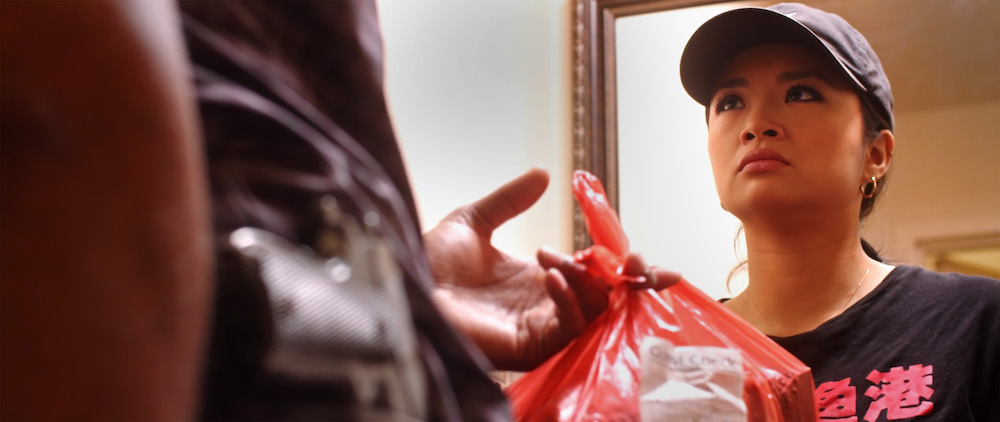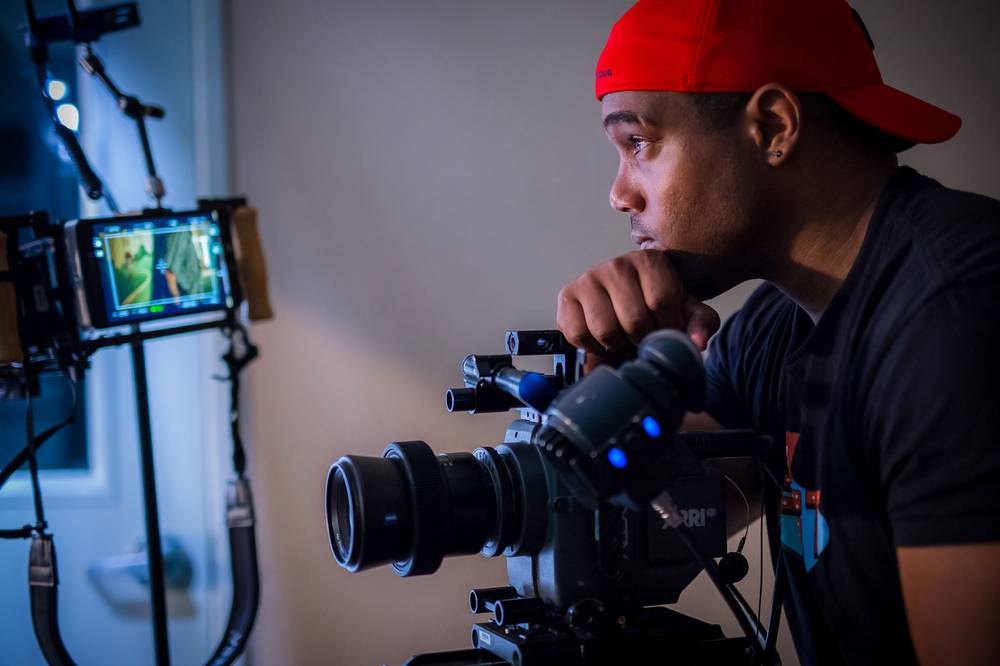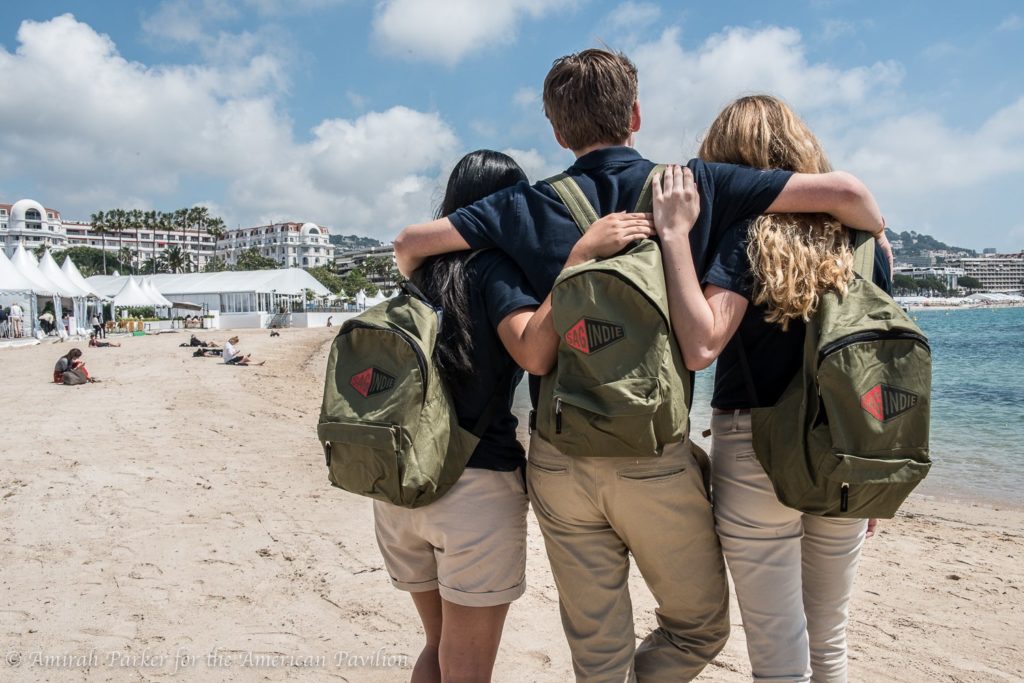“Write what you know” is an edict that has been passed down to aspiring screenwriters for decades. But even for writers taking inspiration from their own life, an outside perspective can take the project to the next level. That’s what happened when filmmaker HISONNI JOHNSON came across Hedy Wong‘s autobiographical screenplay, TAKE OUT GIRL. The story – about a college dropout working for her family’s Chinese restaurant who falls into the criminal underworld – was a personal one for writer/actor Wong. But in collaboration with Johnson, the duo worked to expand its themes while maintaining authenticity in order to bring the film to fruition.
Johnson studied acting at the University of Wisconsin before moving behind the camera as a writer, director, producer, camera operator, cinematographer, editor, and more. His credits include features and shorts that have won awards from over 100 festivals, and Take Out Girl is no exception. His newest film – which premiered at the Cinequest Film Festival – went on to win Best Director at the American Black Film Festival, Narrative Recognition at the Bentonville Film Festival, and the Best Ensemble Prize at Indie Memphis Film Fest (among other accolades). Now, home audiences will get to see Johnson and Wong’s film for themselves when 1091 Pictures releases Take Out Girl on VOD and Digital on May 18.
We got the chance to talk to co-writer/director/producer Hisonni Johnson about what he brought to the film, pulling off a low-budget production in the Vegas heat, working with his cast and crew, and more.
——
COLIN McCORMACK: Take Out Girl is [credited as] screenplay by you and Hedy Wong, with a story by Hedy. How did you two first meet and what sparked you to become collaborators on this?
HISONNI JOHNSON: Hedy Wong wrote the first draft of the film years before she met me and was trying to get [it] off the ground. But she needed special ingredients. More specifically, she needed a filmmaker who could make no budget look like a budget. That was troublesome for her for years, she couldn’t find the right person. Lorin Ly, the man who played Saren, the brother in the film, he and I had worked together about ten years ago. And he remembered this dude who kind of ran all over set adjusting sound, lights, camera; [who] edits, writes, all that stuff, and he recommended me to Hedy. Impressively enough, she took the initiative and decided to invite me out to dinner. She gave me a call and told me she wanted to take me to dinner and she told me the premise of the film. I found myself intrigued but not sold, mostly because the premise is good but I’d seen films like that before. It wasn’t until I met her for dinner that I was astounded at who she was.
There are elements of her that pretty much are Take Out Girl, and that day I met the character I wrote. She was like a combination of Don Corleone mixed with a supermodel [laughs]. I had never met a young lady who’s five-foot-two and beautiful and very petite that commanded so much respect. Also, you would expect her voice to be higher in register, but it wasn’t. When I met her, she was like, [in a deep voice] “Wassup, man? How you doin’?” I was like, “Uhh, okay?” It took me a while to get my bearings, but by the end of the dinner, I found her to be such a unique human being that I realized I had never met anyone like her before. I could put her on-screen jumping rope for 90 minutes and people would find her interesting. And I knew I was going to do the film.
CM: From there, did you take a crack at the next draft of the script or did you both start co-writing it together?
HJ: I ended up putting fingers to keys. I read her draft three or four times and it was a beautiful draft, but it felt more like a docudrama. And she wasn’t the main character. The reason I signed on was to put her on display because I knew I would win if I just put her personality on full display. So I told her I had to do a rewrite, I had to make her the lead, [and] she agreed. And I dove head-first into the script. Every time I hit a little bit of a bump in the road, I would call her and we would spend four or five hours on the phone and we would troubleshoot it and come up with these brilliant ideas to the point where if the phone call ended with us going, “Yeah, yeah! That’s it, that’s it!” I would hang up and immediately start writing again. So it would be a couple of days of writing, I would call her back, “Yeah, yeah! That’s it!” Start writing again, and I banged out the first draft in about three weeks. And we spent about a year refining it. We submitted it to the BlueCat Screenplay Competition, Austin Film Festival, the Black List, and we did really well but I wasn’t convinced it was ready to shoot. So we refined it further and further and we kept making refinements until essentially a month before we shot it.

CM: During that refinement process, you’re obviously refining it for story and character purposes, but were there things – with your experience turning something out on a low budget – in the script you rewrote with [budgetary] constraints in mind?
HJ: Yes. When Hedy brought the project to me I think she saw it as essentially a plot-driven film about getting caught up in criminal activities, but I saw it as a film about family. So I shifted the story to revolve around, obviously, the personality of characters. Tera’s personality when she’s with her mom, Tera’s personality when she’s with the criminals in the neighborhood, when she’s making deliveries, when she’s with customers in the store, and the personalities as they clash. As long as I made it about the people, the locations could be easily shifted and it wouldn’t matter because you weren’t really looking at that. You were looking at the people and paying attention to what they were saying. As long as the dialog and the choices people made were captivating, the rest was going to fall into place.
CM: Some films don’t even have the writer on the set, but you guys had one behind the camera and one in front of the camera. Were there ever moments where things needed to be changed on the fly and you or Hedy had to put your writer’s hat back on and make that change real quick?
HJ: To Hedy’s credit, when we were on set she was very much Take Out Girl. That was what the film needed from her. But yes, you are correct, with a no-budget film everything is a problem [laughs]. So yes, every time we set up for a scene something needed to be tweaked. And the great part about it was Hedy, I, and the entire crew were always heads-up about this. We had a very diverse crew. There was me, a Black man; there was Hedy, a Chinese-American; my producer [Melissa Del Rosario] is Filipina-American; my cinematographer and producer [Alberto Triana] is Cuban-American; we had white members of our crew as well, and the great part about it is when we did work on the fly we had this array of ideas that really came together and made an idea that could have felt very “done before” feel fresh. So the on-set vibe, we switched it up; every time something went “wrong” we saw it as the universe enforcing a better rewrite on the film and we just workshopped it and rehearsed it until we felt like something popped. It was essentially the same scenario [Hedy and I] had on the phone, that, “Yeah, yeah, yeah! That’s it!” but together and in-person. When that happened, we called “Action.”
CM: Where did you guys film?
HJ: We shot in Las Vegas for 90% of the film and then 10% we shot in Riverside, California.
CM: The restaurant is a main location of the film – were you shooting in an operating restaurant or did you find a closed one?
HJ: I found a closed restaurant that was furnished and had the right colors. I spent six or seven months here in Las Vegas just driving around, cruising during the evenings looking for locations that would work, exploring nooks and crannies. I had to find some very impoverished, “hood” looking areas. I had to find restaurants. And to be honest, I found several closed restaurants that were furnished to choose from. It’s amazing, that old adage, “You can either be good, fast, or cheap.” When you thoroughly concede to the idea that you’re not being expensive and you just start putting in the time, you can move mountains.
CM: You talked about your diverse crew. Were you able to utilize local crews in Nevada, were you bringing in people from LA? How did you assemble that core team?
HJ: All but one crew member were from Vegas. Genaro Marzan, our first AC and our B-cam camera op, was from LA. But he was also from an internship program that I ran through the University of California Riverside when I lived there seven years ago. And I trained him myself, so he knew my workflow better than everybody here in Vegas.
I cast the cast through various means. Ski Carr, the gentleman who played Lalo, I’ve been working with him for the better part of ten years. He’s one of my field generals as I call him; he’s one of the actors that I love to put in my films along with new talent because he brings them up to his level and he sets an energy on set that makes everybody feel welcome and excited. The same thing with J. Teddy Garces, those two I’ve been working with for the same amount of time and they do the same thing. Both of those guys were [cast] from me writing for them. Obviously, Hedy brought the project to me. Lorin Ly brought the project to me by remembering who I was and telling Hedy about it. Lynna Yee, the woman who played Wavy, was by far the hardest character to find. I looked for her for about a year and went through several actresses. It was difficult because it’s hard to find an Asian-American woman who looks her age. If she is old enough to be a mom and old enough to have gray hair, she doesn’t have any of those things – she looks like she’s in her early thirties. If she looks old enough to be a mom, she’s like 70 or 80 and retired and does not want to be on her feet for 12 hours a day [laughs]. It was just a really hard thing. But Lynna Yee was amazing because she doesn’t speak Cantonese, she learned it for the film; she doesn’t speak Spanish, she learned it for the film; she doesn’t have a backache, she played that for the film. She was everything we needed her to be. [Lynna] was from LA, J. Teddy Garces was from LA, Ski Carr was from LA. I think it was a 50/50 split in the cast; 50% were in from LA, 50% were from Vegas.
CM: Obviously, it’s a heavily Asian-American and Latinx cast. Were you finding a relief – for lack of a better word – or an energy from the cast given that opportunities for three-dimensional and lead roles are not as abundant as they should be for Asian and Latinx actors?
HJ: That’s a difficult question. I think the best way to answer that is that the energy on set was outstanding. We really did turn into a family and every take, every shot, every setup, you felt everybody giving everything they had. And to be honest, I really don’t know where that energy started. I could say the actors brought it, but I know there were times when the crew did. I feel incredibly fortunate to have had everyone excited about it. I never really took the time to think about whether or not that was because they don’t get these opportunities. It felt like everyone understood how mutually beneficial it could be and no one wanted to be outworked by anyone else on set and no one wanted to bring the energy down, regardless of how tired they were. Because we shot in Las Vegas in the summer, so it was hot, it was crazy. So to have that output, no fights, no arguments, people laughing, and BTS of people dancing and joking, I don’t know how I got so lucky.
CM: As the director, producer, and co-writer, you were also co-DP and co-editor. What was the toughest thing about wearing so many hats?
HJ: They feel like one single task, to be completely honest. I always fancy myself a filmmaker and not a director. I believe even if I was tasked with just sitting behind the camera and being the director, my brain would still be functioning the same. I would just be demonstrating an insane amount of restraint. I would want to know if sound was right, I would be critiquing the shot size and composition and lighting and color the same way I always do. And I’m always editing because editing is what I’ve been doing the longest. The best way I could answer that is to me it feels complimentary. It’s like butter on popcorn, you just wouldn’t do one without the other.
CM: The film had its festival premiere just before COVID hit. What was that period like for you when things shut down just as your film’s rollout to the world was gearing up?
HJ: It was terrifying. It was terrifying as a human being because the world was changing faster than I had ever witnessed it in my life and I didn’t know how things were going to turn out. And there also was a “woe is me” moment where I thought I was maybe destined to fail because I’d made this film and out of all the times in history that this could have happened, the film industry is being affected when I’m trying to put a film out there. I also was highly aware that half the film festivals I’d submitted to were shut down or canceled. And the rest of the film festivals I’d submitted to were now changing how many films they were even going to accept because the pandemic was hurting their bottom line. So I had myriad obstacles to overcome, but it makes it that much sweeter because here I am on the phone chatting with you. And we’ve gotten into over 40 film festivals; my goal was to get into 20 film festivals and we got into over 40. My goal was to win one award and we’ve won almost 20. My goal was to get a good distribution deal and we did; we would have been in theaters if not for the pandemic. So I couldn’t be more thrilled with how things turned out, but I’ll always wonder what it would have been had the pandemic not limited our potential.
CM: To wrap things up, what is next for you now?
HJ: What’s next is I’m actually shooting and editing my next film, a short film called Blunt, which is the story of an interracial lesbian couple who use the power of cannabis to ease the racial tension between themselves and their parents. And I’m also shooting another short film this month – we’re doing two – it’s called Novenario that is directed by my partner Alberto Triana. That’s the story of a Cuban-American man – in Cuban culture, a novenario is essentially a celebration of a person in your family who’s passed on – and this gentleman finds himself having to spend eight days in a house with a family he doesn’t know or relate to because his father made him so American. We’re doing a short film anthology that is all about coming-of-age moments for underrepresented people and we can’t wait to get our third film slated. Then a feature film I’m doing later in the year, super excited about that. That’s all I got on my plate right now.
__
Thanks to Hisonni for discussing TAKE OUT GIRL. Follow the film on Facebook or Instagram.
If you’re an independent filmmaker or know of an independent film-related topic we should write about, email blogadmin@sagindie.org for consideration.



